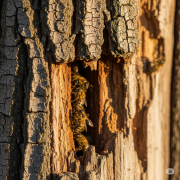Aside from being important workers in the ecosystems and human health, bees can do more than that. Unfortunately, several species are at high risk due to parasite infestations, the use of herbicides, and the destruction of their habitats, including bee homes. These dangers may lead to the damage of biodiversity, food security, and public health. This “Threatened Bees” page is for you if you want to know more about bee populations, how they affect human health, and how we can protect them.
The Quiet Killer: Pesticides
 Neonicotinoids and other systemic pesticides are important components of current pest control. Honey and pollen, which are two of the most important foods for bees, contain these chemicals. A common outcome of exposure is:
Neonicotinoids and other systemic pesticides are important components of current pest control. Honey and pollen, which are two of the most important foods for bees, contain these chemicals. A common outcome of exposure is:
- Death or paralysis immediately
- Challenges with movement and cognition that persist over time
- Reduced resistance to disease due to compromised immune systems
According to research,
Pollination capacity and biodiversity are both reduced when bees bring pesticides back to the hive and cause entire colonies to collapse.
Parasites and Other Agents that Cause Infection
Although small in size, the Varroa destructor bug is also a major problem. This tiny parasite feeds on the blood of honey bees. Aside from that, they are also virus spreaders that produce acute bee paralysis and deformed wing virus. Without human involvement, scientific simulations show that mite populations can spread and viruses can infect beehives. The survival of beehives currently depends on controlling mite infestations.
Why is Bee Health Important for Human Health?
Here are its advantages:
- Decrease crop output and increase the prices of food due to the reduction of the bee population
- The dietary options decline
- Deterioration of environmental services that promote human well-being
An Approach to Bee Health Monitoring Driven by Technology
Hope for bee conservation has been offered by recent advances in artificial intelligence. A novel AI-powered solution surpasses single-modality monitoring by using audio and visual data to monitor hive health with an accuracy of over 92%. Beekeepers can now proactively take precautionary steps by using these non-invasive instruments to detect diseases early on.
Help Save Bees suggests a few easy things you can do to help bee populations:
- Do your part to revolutionize agriculture by not using pesticides in your garden.
- Make sure bees have reliable food supplies by planting native plants that are beneficial to bees.
- Build safe havens for wildlife, such as beehives or nesting areas.
- Especially during the summer, provide clear water with stones to land on.
Last Remarks
It is important to protect bees because they are a species, and the health of people living on Earth depends on a complex web of life that works. Cut down on pesticide use, get rid of bee parasites, and use technology like health tracking systems driven by AI to protect bees and our future. We need to move right away because our lives are in danger.
